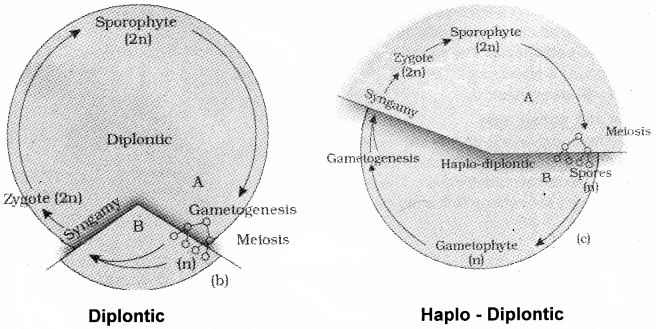Kerala Plus One Botany Notes Chapter 2 Plant Kingdom
Different Plant Groups:
- Algae
- Bryophytes
- Pteridophytes
- Gymnosperms
- Angiosperms.
Types of classification:
1. Artificial system of classification:
The systems of classification based morphological characters such as habit, colour, number and shape of leaves, etc i.e based on vegetative characters or on the androecium structure. eg: Linnaeus classification.
2. Natural system of classification:
The systems of classification based on not only the external features, but also internal features, like ultrastructure, anatomy, embryology and phytochemistry. eg: George Bentham and Joseph Dalton Hookers classification
3. Phylogenetic system of classification:
The systems of classification based on evolutionary relationships between the various organisms. eg: Englerand prantl.
Taxonomy in modern approach:
1. Numerical Taxonomy
In this, number and codes are assigned to all the characters and the data are processed. This is carried out using computers based on all observable characteristics.
2. Cytotaxonomy:
In this cytological information like chromosome number, structure and behavior are considered.
3. Chemotaxonomy:
It is based on chemical constituents of the plant.
1. Algae:
Characterestic features:
Algae are chlorophyll-bearing, simple, thalloid, autotrophic and largely aquatic (both fresh water and marine) organisms.
Size of algal forms:
- Microscopic unicellular forms eg Chlamydomonas,
- Colonial forms eg Volvox
- Filamentous forms eg Ulothrix and Spirogyra.
Reproduction:
1. Vegetative reproduction:
It occures by fragmentation. Each fragment develops into a thallus. .
2. Asexual reproduction:
lt occures by the production zoospores. They are flagellated (motile) and on germination gives rise to new plants.
3. Sexual reproduction:
It takes place through fusion of two gametes.
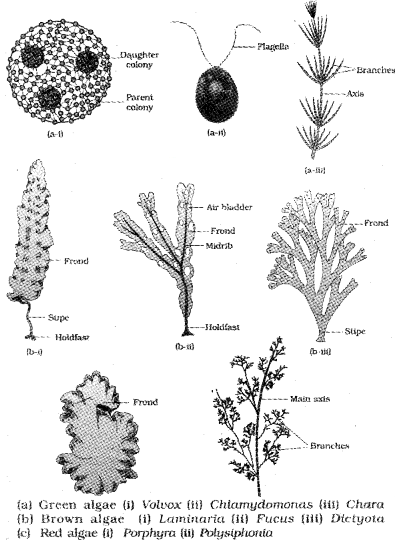
(A) Isogamous:
These gametes are flagellated and similar in size (as in Chlamydomonas) or non-flagellated (non-motile) but similar in size (as in Spirogyra).
(B) Anisogamous:
It is the fusion of two gametes dissimilar in size. eg: species of Chlamydomonas
(C) Oogamous:
It is the fusion between one large, non-motile (static) female gamete and a smaller, motile male gamete eg: Volvox, Fucus.
Economic imoportance:
- Half of the total carbon dioxide fixation on earth is carried out by algae through photosynthesis.
- Many species of Porphyra, Laminaria and Sargassum are among the 70 species of marine algae used as food.
- Certain marine brown and red algae produce large amounts of hydrocolloids (water holding substances), eg: algin (brown algae) and carrageen (red algae) are used commercially.
- Agar obtained from Gelidium and Gracilaria are used to grow microbes and in preparations of ice-creams and jellies.
- Chlorella and Spirullina are unicellular algae, rich in proteins and are used as food by space travellers.
Three main classes of algae:

Chlorophyceae (Green algae):
Salient features:
- The plant body may be unicellular, colonial or filamentous. The dominant green pigments are chlorophyll a and b.
- The chloroplasts may be discoid, plate-like, reticulate, cup-shaped, spiral or ribbon-shaped in different species.
- The storage bodies called pyrenoids located in the chloroplasts. Pyrenoids contain protein besides starch.
- Green algae have a rigid cell wall made of an inner layer of cellulose and an outer layer of pectose.
- Vegetative reproduction usually takes place by fragmentation.
- Asexual reproduction is by flagellated zoospores produced in zoosporangia.
- The sexual reproduction may be isogamous, anisogamous or oogamous.
eg: Chlamydomonas, Volvox, Ulothrix, Spirogyra and Chara.
Phaeophyceae (Brown algae):
Salient features:
- They are mainly found in marine habitats.
- The size of plant body range from simple branched, filamentous forms (l=ctocarpus) to profusely branched forms such as kelDs (height 100 metres).
- They possess chlorophyll a, c, carotenoids and xanthophylls. Fucoxanthin is present in large amount.
- Food is stored as complex carbohydrates in the form of laminarin or mannitol.
- The vegetative cells with cellulosic wall is covered on the outside by a gelatinous coating of algin.
- The plant body is attached to the substratum by a holdfast, and has a stalk, the stipe and leaf like photosynthetic organ-the frond.
- Vegetative reproduction takes place by fragmentation.
- Asexual reproduction is by biflagellate zoospores that are pear-shaped and have tyvo unequal laterally attached flagella.
- Sexual reproduction may be isogamous, anisogamous or oogamous.
- The gametes are pyriform (pear-shaped) and bear two laterally attached flagella.
eg: Ectocarpus, Dictyota, Laminaria, Sargassum and Fucus.
Rhodophyceae(Red algae):
Salient features:
- Majority are marine and found in the warmer areas.
- The red thalli of most of the red algae are multicellular. The chlorophyll pigments are chi a,chi d.
- The dominant red pigment is r-phycoerythrin.
- The food is stored as floridean starch similar to amylopectin and glycogen in structure.
- The red algae usually reproduce vegetatively by fragmentation.
- They reproduce asexually by non-motile spores and sexually by non-motile gametes.
- Sexual reproduction is oogamous and accompanied by complex post fertilisation developments.
eg: Polysiphonia, Porphyra, Gracilaria and Gelidium.
2. Bryophytes:
Amphibians of the plant kingdom?
Because these plants are found in damp, humid and shaded localities and dependent on water for sexual reproduction.
Salient features:
- Thallus is prostrate or erect, and attached to the substratum by unicellular or multicellular rhizoids.
- They lack true roots, stem or leaves.
- The main plant body of the bryophyte is haploid. It produces gametes, hence is called a gametophyte.
- The male sex organ is multicellular antheridium. They produce biflagellate antherozoids.
- The female sex organ called archegonium it is flask-shaped and produces a single egg.
Sexual reproduction:
Antherozoid moves through water they come in contact with archegonium and fuses with the egg to produce the zygote. Zygotes produce a multicellular body called a sporophyte.
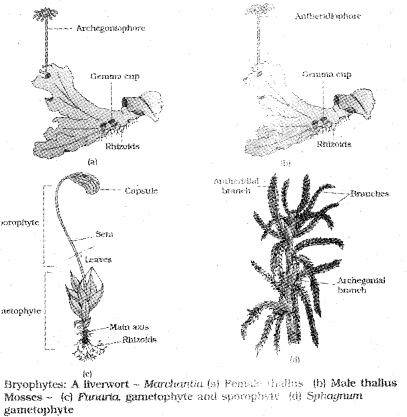
What is the nature and development of sporophytes of bryophytes?
The sporophyte is not free-living but attached to the photosynthetic gametophyte Some cells of the sporophyte undergo reduction division (meiosis) to produce haploid spores. These spores germinate to produce gametophyte.
Economic importance:
- They play an important role in plant succession on bare rocks/soil. They decompose rocks making the substrate suitable for the growth of higher plants.
- Some mosses provide food for herbaceous mammals, birds and other animals.
- Sphagnum, a moss, provide peat that is used as fuel, and because of their capacity to hold water as packing material for trans-shipment of living material.
- Mosses form dense mats on the soil hence it prevents soil erosion.
The bryophytes are divided into liverworts and mosses.
Liverworts:
Growing locality:
The liverworts grow in moist, shady habitats such as banks of streams, marshy ground, damp soil, bark of trees and deep in the woods.
What is nature of plant body?
The plant body of a liverwort is thalloid, eg: Marchantia.
| Asexual reproduction in liverworts takes place by fragmentation of thalli, or by the formation of specialised structures called gemmae |
Features of Gemmae and its development:
Gemmae are green, multicellular, asexual buds. It is detached from the parent body and germinate to form new individuals.
Structure of sporophvte and spore development:
The sporophyte is differentiated into a foot, seta and capsule. After meiosis, spores are produced within the capsule. These spores germinate to form free-living gametophytes.
Mosses:
Spore germination and protonema:
In the life cycle of bryophytes, spore germinate and forms a creeping, green, branched and a filamentous stage called protonema. The second stage is the leafy stage, which develops from the secondary protonema as a lateral bud.
Features of leafy stage:
They consists of spirally arranged leaves and multicellular branched rhizoids. This stage bears the sex organs. It is the true gametophyte.
Vegetative reproduction:
It takes place by fragmentation and budding in the secondary protonema.
Sexual reproduction.
In sexual reproduction, the sex organs are antheridia and archegonia. After fertilisation, the zygote develops into a sporophyte, consisting of a foot, seta and capsule.
Which group of brvophvte shows well developed sporophyte?
The sporophyte in mosses is more elaborate than that in liverworts. The mosses have an elaborate mechanism of spore dispersal. eg: Funaria, Polytrichum and Sphagnum
3. Pteridophytes:
Salient features:
- The Pteridophytes are the first terrestrial plants that possess vascular tissues – xylem and phloem. This group includes horsetails and ferns.
- They are frequently grown as ornamentals.
- The pteridophytes are found in cool, damp, shady places and require water for fertilisation .
- The main plant body is a sporophyte which is differentiated into true root, stem and leaves .
- The leaves in pteridophyta are small (microphylls) as in Selaginella or large (macrophylls) as in ferns.
- The sporophytes bear sporangia by leaf-like appendages called sporophylls.
- In some cases sporophylls forms distinct compact structures called strobili or cones (Selaginella, Equisetum).
- The sporangia produce spores by meiosis in spore mother cells.
- The spores germinate to give rise multicellular, free-living, photosynthetic thalloid gametophytes called prothallus.
- The gametophytes bear male and female sex organs called antheridia and archegonia, respectively.
Sexual reproduction:
How do the sporophytes form?
Water is required for transfer of antherozoids to the mouth of archegonium. Fusion of male gamete with the egg present in the archegonium result in the formation of zygote. It undergoes divisions and forms multicellular well-differentiated sporophyte which is the dominant phase of the pteridophytes.
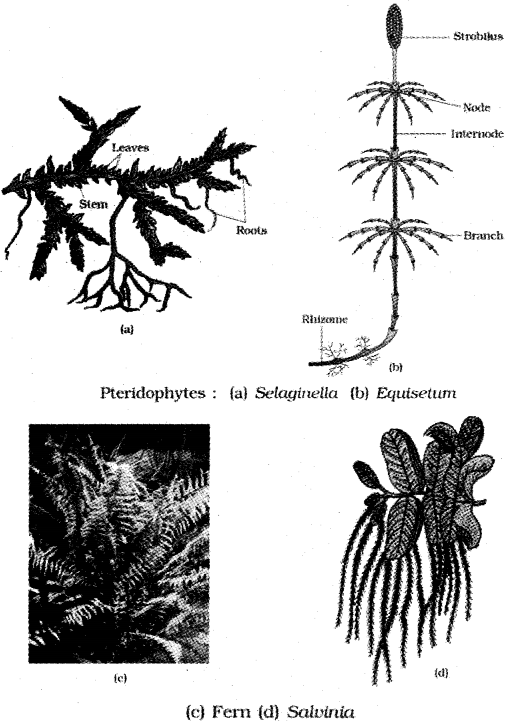
Distiquish between homosporous and heterosporous type or Heterospory is considered as important step in evolution why?
Majority members produce spores are of similar kinds such plants are called homosporous. Few members produce two kinds of spores, macro (large) and micro (small) spores, are-known as heterosporous. eg: Selaginella and Salvinia.
The megaspores and microspores germinate and give rise to female and male gametophytes, respectively. The development of the zygotes into young embryos take place within the female gametophytes. This event is a precursor to the seed habit considered an important step in evolution..
The pteridophytes are further classified into four classes:
- Psilopsida(Psilotum)
- Lycopsida (Selaginella, Lycopodium)
- Sphenopsida (Equisetum
- Pteropsida (Dryopteris, Pteris, Adiantum).
4. Gymnosperms:
Salient features:
1. They are naked seed bearing plants in which the ovules are not enclosed by ovary wall and remain exposed.
2. Tap roots have fungal association in the form of mycorrhiza (Pinus), while in some others (Cycas) small specialized roots called coralloid roots are associated with N2-fixing cyanobacteria.
3. The stems are unbranched (Cycas) or branched (Pinus, Cedrus).

4. The leaves are well-adapted to withstand extremes of temperature, humid ity and wind. .
How can conifers adapt to live in extreme temperature condition or water deficient soil?
- In conifers, the needle-like leaves that reduce the surface area. .
- Thick cuticle and
- sunken stomata
All these characters help to reduce water loss.
5. In Cycas the pinnate leaves persist for a few years.
6. They produce haploid microspores and megaspores i.e heterosporous. These spores are produced within sporangia that are borne omsporophylls which are arranged spirally along an axis to form compact strobili or cones. The strobili bearing microsporophylls and microsporangia are called male strobili.
The microspores develop into a male gametophytic generation. This reduced gametophyte is called a pollen grain. The pollen grain is released from the microsporangium. The cones bearing megasporophylls with ovules or megasporangia are called female strobili.
7. The male or female cones borne on the same tree (Pinus) or on different trees (Cycas).
Development of female qametophyte:
The ovules are borne on megasporophylls that contains nucellus. The megaspore mother cell of nucellus divides meiotically to form four megaspores. One of the megaspores enclosed within the megasporangium (nucellus) develops into a multicellular female gametophyte that bears two or more archegonia
1. The male and the female gametophytes remain within the sporangia retained on the sporophytes.
2. The pollen tube carrying the male gametes grows towards archegonia in the ovules and discharge their contents near the mouth of the archegonia. Following fertilisation, zygote develops into an embryo and the ovules into seeds. These seeds are not covered.
Which is the tallest tree species in world?
Giant redwood tree Sequoia is one of the tallest tree species.

5. Angiosperms (Flowering plants):
Salient features:
1. In this the seeds are enclosed by fruits.
Range of size:
- Microscopic-Wolfie
- Tall trees- Eucalyptus(o\ier 100 metres).
2. Two classes in angiosperms:
- Dicotyledons (two cotyledons in their seeds)
- Monocotyledons (one cotyledon)
3. The male sex organs in a flower is the stamen. Each stamen consists of a slender filament with an anther at the tip. The anthers produce pollen grains.
4. The female sex organs is the pistil or the carpel. Pistil consists of an ovary enclosing one to many ovules. The highly reduced female gametophytes (embryosacs) found within ovules.
5. Typical embryosac is 7 celled and 8 nucleate Each embryo-sac has a three-celled egg apparatus – one egg cell and two synergids, three antipodal cells and two polar nuclei. The polar nuclei eventually fuse to produce a diploid secondary nucleus. The cells of an embryo-sac is haploid.
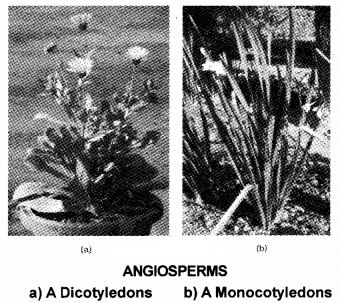
Pollination and pollen tube:
Pollen grain from anther falls on the stigma of a pistil is termed as pollination. The pollen grains germinate and produce pollen tubes that reach the ovule. The pollen tubes enter the embryo-sac where two male gametes are discharged.
Double fertilization:
What are the products and process of double fertilization?
One of the male gametes fuses with the egg cell to form a zygote. This is called syngamy. The other male gamete fuses with the diploid secondary nucleus to produce the triploid primary endosperm nucleus (PEN). This is called Triple fusion. Because of the involvement of two fusions, this event is termed as double fertilization.
Post fertilization changes and significance of edosperm:
The zygote develops into an embryo and the PEN develops into endosperm which provides nourishment to the developing embryo. The synergids and antipodals degenerate after fertilisation. After fertilization ovules develop into seeds and the ovaries develop into fruits.
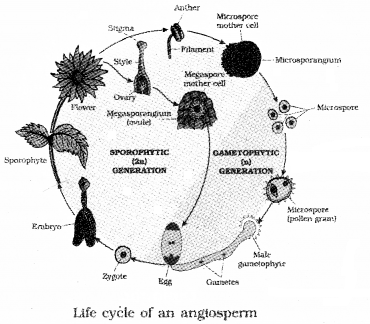
Plant Life Cycles And Alternation Of Generations:
In plants, both haploid and diploid cells can divide by mitosis. This ability leads to the formation of different plant bodies – haploid and diploid.
1. Haplontic life cycle:
How do gametophyte forms?
Meiosis in the zygote results in the formation of haploid spores. Then, these spores are divide mitotically and form the gametophyte.
What is the nature of sporophyte and gametophyte?
Sporophytic generation is represented only by the one-celled zygote. The dominant, photosynthetic phase is the free-living gametophyte.
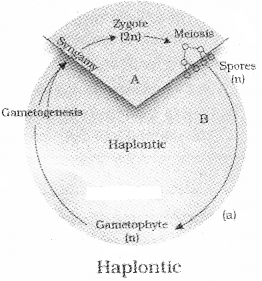
2. Diplontic life cycle What is the nature of sporophyte and qametophyte?
The diploid sporophyte is the dominant, photosynthetic, independent phase of the plant. The gametophytic phase is represented by the single to few-celled haploid gametophyte. eg: gymnosperms and angiosperms.
3. Haplo-diplontic:
It is an intermediate condition in which both phases are multicellular and often free-living.
What is the nature of both sporophyte and gametophyte?
A dominant, independent, photosynthetic phase is represented by a haploid gametophyte and it alternates with the short lived multicelluler sporophyte dependent on the gametophyte. eg: Bryophytes and pteridophytes.
Algae in haplo-diplontic and diplontic stage:
- Ectocarpus, Polysiphonia and kelps are haplo-diplontic.
- Fucus, an alga is diplontic.
